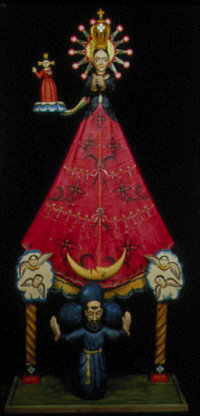
Cristo by Charlie Carrillo -Hide painting, like this contemporary Cristo, has a centuries-long history in the Southwest.
Santos:
The Art of Devotion
From the Collection of
Barbe Awalt (MA '76) and Paul Rhetts
In the first centuries after the Spanish settled the Southwest and introduced Catholicism 400 years ago, most people dwelt in villages miles from a church. They worshiped instead at home altars and in village chapels, where artwork depicting saints and holy scenes (santos) became a focus for personal devotion. Santos took several forms, including hide paintings, three-dimensional carvings (bultos), and paintings on prepared board (retablos). "The art is very simple. It speaks to people," says Barbe Awalt (MA '76), who together with her husband, Paul Rhetts, has accumulated one of the largest collections of santos in the country (see Contributors section). The pieces featured here are part of their traveling exhibit, "Our Saints Among Us: 400 Years of New Mexican Devotional Art."

Muerte by Charlie Carrillo La Sebastiana, the Muerte or Death Figure, is traditional in New Mexico. She is popular during Lent, especially on Good Friday when she is paraded through villages as a visible reminder that death is always around.
Barbe Awalt (MA'76) and her husband, Paul Rhetts, began collecting santos, paintings and carvings that depict saints and holy scenes, shortly after they moved to New Mexico in the late 1980s (See "Santos: The Art of Devotion,"). In the years since then their collection has grown to include 450 pieces (their oldest dates to 1770), and they've become good friends with many of the contemporary artists, or santeros, who are carrying on the 400-year-old tradition of devotional art.

Nuestra Señora del Pueblito de Querétero
by Charlie CarrilloThis six-foot-high bulto of the Virgin coming forth with her angels exhibits all the traditional art forms of New Mexico. Her skirt is a hollow frame (fabric stretched over a dress-maker's form then gessoed to be stiff), and there are gold leaf accents, straw work, and sterling silver medallions on her crown. The figure at the bottom is St. Francis. The three globes represent the three Franciscan orders in the New World.
"It's a classic case of an art form taking over your life," says Awalt, who with her husband has written six books on the subject and has launched a quarterly magazine on the art and culture of Hispanic New Mexico, Tradición Revista.

Blue Cristo by Charle Carrillo If Christ were crucified in northern New Mexico at Easter, his skin would turn blue, explains artist Charlie Carrillo of his color choice here. Insulated against foreign influence, artists traditionally gave their saints a distinctly New Mexican look.
Earlier this year, they turned their collection into a traveling exhibit, which is being featured at sites throughout the Southwest. "It's really hit a chord with people that we never would have predicted," Awalt says. "It's not something they take lightly."
In the exhibit, the couple includes two altars where viewers can stop to kneel and pray--in keeping with the very personal devotional role santos have played in the four centuries since the Spanish introduced Catholicism to the Southwest. "For the people of New Mexico, the saints were a part of the family," explains Awalt. Likewise, [santos] themselves were "not considered artwork, but a member of the family." --SD

Nuestra Señora de la Paz by Krissa Marie Lopez
Note: Photos appearing in "Santos: The Art of Devotion," were taken by Awalt and Rhetts, with the exception of "Cristo" by Robert Reck, "Nacimiento" by Ron Behrmann, and the "bulto, also by Behrmann. All three of these shots appeared in Charlie Carrillo: Tradition and Soul.
No comments:
Post a Comment